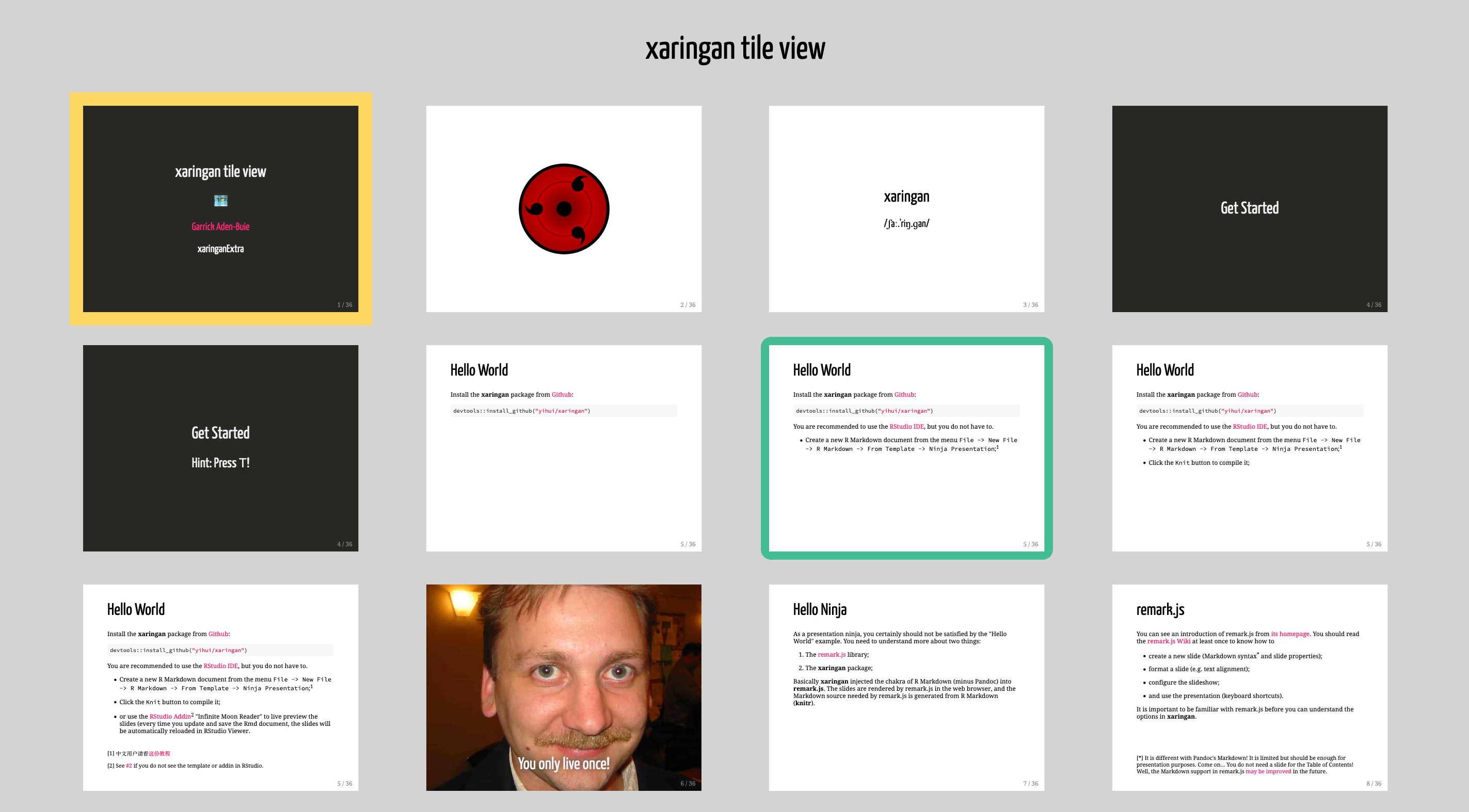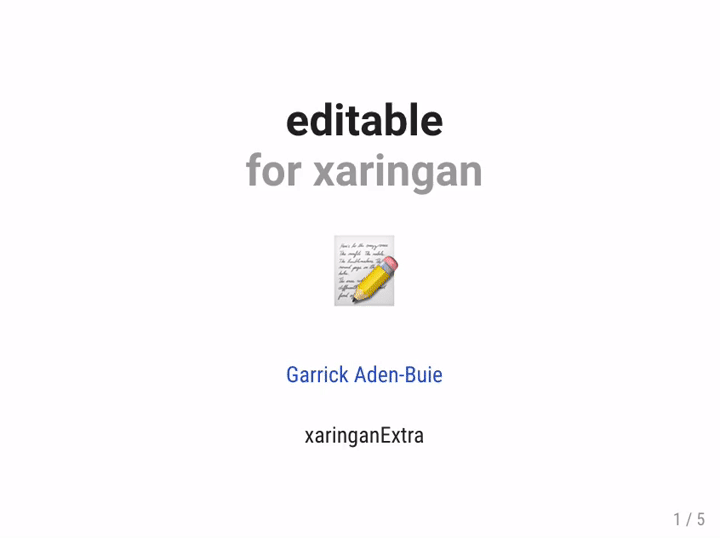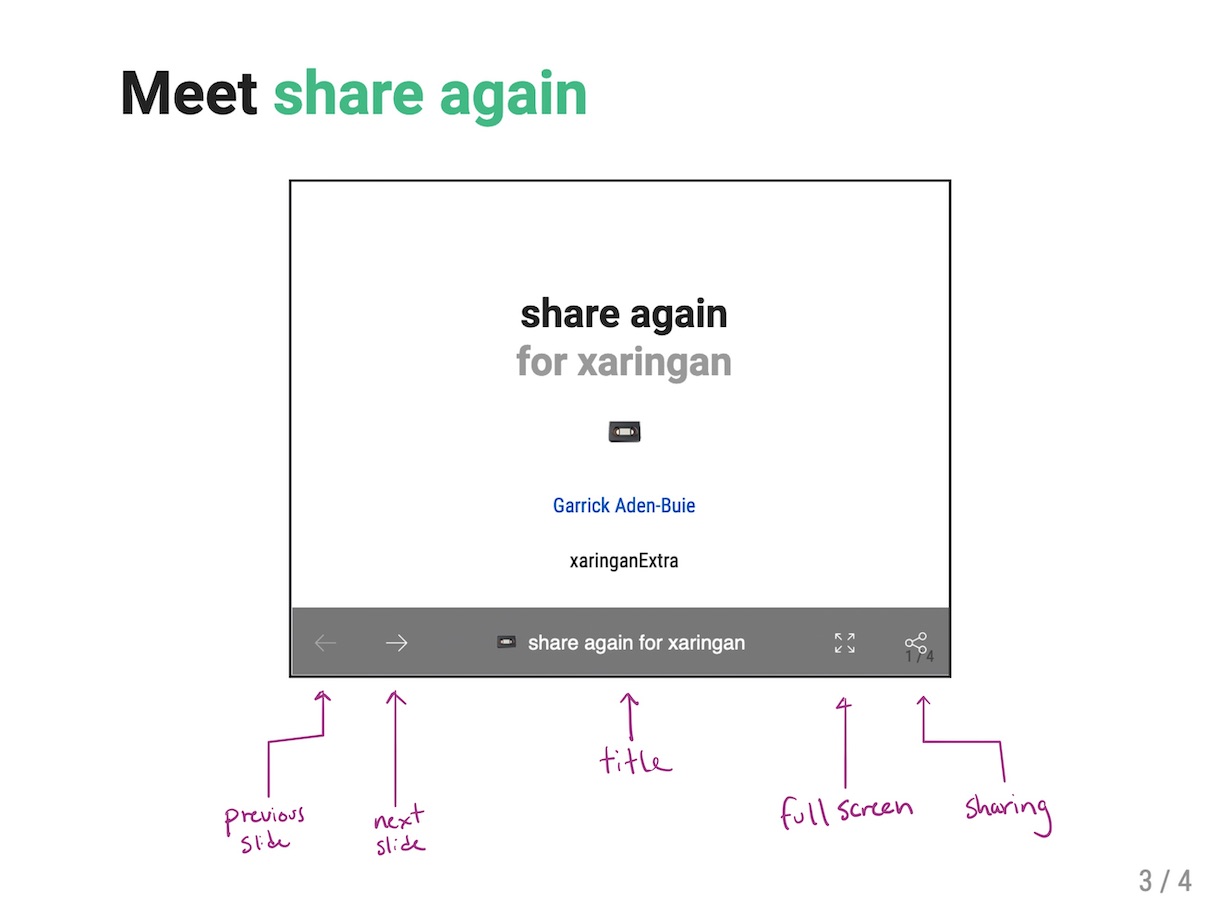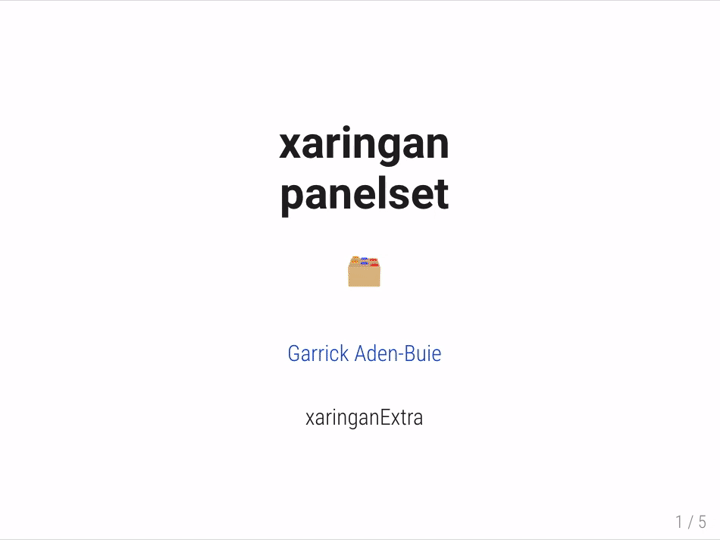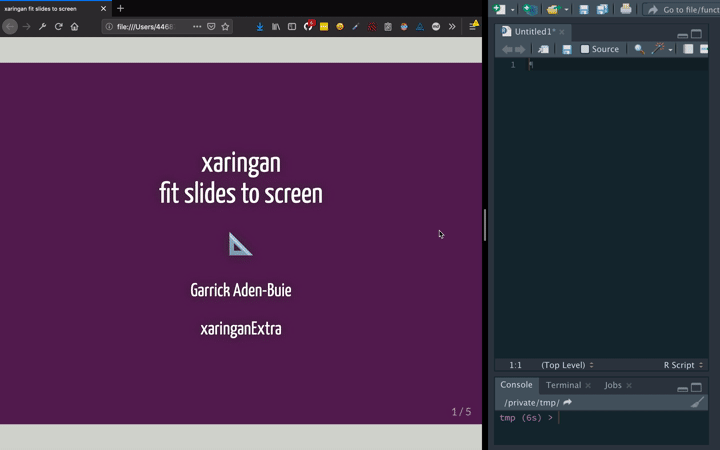gadenbuie / Xaringanextra
Programming Languages
Projects that are alternatives of or similar to Xaringanextra
xaringanExtra
xaringanExtra is a playground of enhancements and extensions for
xaringan slides.
- Add an overview of your presentation with tile view
- Make your slides editable
- Share your slides in style with share again
- Broadcast your slides in real time to viewers with broadcast
- Scribble on your slides during your presentation with scribble
- Announce slide changes with a subtle tone
- Animate slide transitions with animate.css
- Add tabbed panels to slides with panelset
- Add a logo to all of your slides with logo
- Add a search box to search through your slides with search
- Use the Tachyons CSS utility toolkit
- Add a live video feed of your webcam
- Add one-click code copying with clipboard
- Fit your slides to fill the browser window
- Add extra CSS styles
Each item can be enabled separately, or load everything at once with a single call.
```{r xaringanExtra, echo=FALSE}
xaringanExtra::use_xaringan_extra(c("tile_view", "animate_css", "tachyons"))
```
Installation
You can install the current version of xaringanExtra from GitHub.
# install.packages("devtools")
devtools::install_github("gadenbuie/xaringanExtra")
🗺 Tile View
📺 Tile View Demo
Tile view gives you a way to quickly jump between slides. Just press O (the letter O for Overview) at any point in your slideshow and the tile view appears. Click on a slide to jump to the slide, or press O to exit tile view.
To add tile view to your xaringan presentation, add the following code chunk to your slides’ R Markdown file.
```{r xaringan-tile-view, echo=FALSE}
xaringanExtra::use_tile_view()
```
Tile view is heavily inspired by (and is essentially a port to Vanilla JavaScript of) a jQuery remarkjs hook by the same name by Stephen Hesperus.
📝 Editable
📺 Editable Demo
Editable gives you a way to write directly inside your slides, updating
your content live. Make any element of your slides editable by using the
.can-edit[...] class.
Make your slides editable with the following code chunk.
```{r xaringan-editable, echo=FALSE}
xaringanExtra::use_editable(expires = 1)
```
Then, to make a component of your slides editable, use the .can-edit[]
class.
## .can-edit[You can edit this slide title]
Editable fields that only have the .can-edit class are reset whenever
the slides are re-loaded in your browser. If you want to store the
edited values and have them persist across browser sessions, give each
editable field a .key-<NAME> class. Be sure to make each key unique
and note that the key name must be a valid CSS class, i.e. it cannot
contain spaces.
## .can-edit.key-firstSlideTitle[Change this title and then reload the page]
For more complicated HTML elements, it’s best to make only spans of text editable, such as
Hello, .can-edit[world], and welcome to my talk!
or to use placeholder text.
## A few of my favorite things
.can-edit.key-likes[
- thing one
- thing two
]
📼 Share Again
📺 Share Again
Share your slides in style with share again! It adds a share bar to your slides that only shows up when they’re embedded in another page. The bar adds easy slide navigation, quick access to full screen views, and a share menu for one-click (or tap!) sharing on social media sites.
Add share again to your slides in three easy steps.
-
Add
use_share_again()to your slides```{r share-again, echo=FALSE} xaringanExtra::use_share_again() ``` -
Style your share bar and choose social media sites
```{r style-share-again, echo=FALSE} xaringanExtra::style_share_again( share_buttons = c("twitter", "linkedin", "pocket") ) ``` -
Embed your slides in blogdown or R Markdown websites
```{r embed-xaringan, echo=FALSE} xaringanExtra::embed_xaringan(url = "share-again.html", ratio = "4:3") ```embed_xaringan()works with any xaringan presentation, share again not required!Here’s what your slides will look like in an R Markdown HTML document.
📡 Broadcast
📺 Broadcast Demo
Broadcast lets others follow along, in real time! Built with PeerJS, broadcast give you a unique URL to share with your viewers. Then, when they load your slides, their slides will automatically follow you as you present!
To equip your slides with broadcast capabilities, add the following
chunk to your slides’ .Rmd file.
```{r broadcast, echo=FALSE}
xaringanExtra::use_broadcast()
```
Then, host your slides online, either on a personal webpage, or through Netlify, GitHub Pages, GitLab Pages, or another service.
When you want to present, open the version of your slides hosted online in a modern browser. Then press P to enter the presenter view. Click on the Broadcast button to start broadcasting.
After a short moment, if everything works, the broadcast button will turn into a broadcast link. Share this link with your audience. When they open the link, their browser will connect with yours and from then on, whenever you advance or change slides, your viewer’s slides will move to the current slide.
Note that the broadcast link is unique and, as the presenter, is remembered for 4 hours. After 4 hours of inactivity, a new link will be generated. In general, create and share the broadcast link just before or as your event starts and certainly not more than an hour before the presentation.
How It Works
PeerJS creates a direct, peer-to-peer connection between your browser and your viewer’s browsers. A third party PeerJS server is used to initially facilitate the connection using the broadcast ID to connect with the presenter’s browser.
After the connection is made, data is sent directly between browsers and the PeerJS server is no longer involved. Furthermore, at no time is any information about your presentation transmitted over the network. When you move to a slide, say for example slide 11, broadcast announces “Slide 11” to any connected viewers and JavaScript in their browser moves their presentation to slide 11.
This has two consequences:
-
Viewers can move around and look at slides other than the one currently active in the presenter’s browser. When the presenter changes slides, however, all viewers’ slides will move to the new slide.
-
If your slides involve interactivity, such as htmlwidgets or [panelset], changes made in the presenter’s view aren’t replicated for viewers. Viewers will be taken to the same slide as the presenter, but they will need to click on their own to follow interactively.
Extra Details
It’s worth mentioning a few details. First of all, the broadcaster needs to be connected first before viewers connect. If a viewer connects before the broadcaster starts (or restarts), they should reload the link to reconnect.
Similarly, if the broadcaster reloads their slides, viewers will also need to reload to reconnect. But once everyone is connected, a message will appear for the viewer to prompt them to reconnect.
If you are the presenter and you load the broadcast link, the broadcst
will automatically reconnect and start broadcasting. If you want to view
your slides without broadcasting, just load the plain URL for the slides
without the ?broadcast=... portion. From this view, you can restart
the broadcast from the presenter view and if the broadcast ID is still
valid that ID will be used. To reset the broadcast ID without waiting 4
hours, load your slides with ?broadcast=1 and new broadcast link will
be created at the next broadcast.
👩🎨 Scribble
📺 Scribble Demo
Scribble lets you draw on your xaringan slides. Click the pencil icon or press S to begin drawing. Pressing S or starting the drawing mode toggles the scribble toolbox. There, you’ll find the eraser button, which helps you remove lines from your drawing. Or click the trash button to clear the drawings on the current slide.
```{r xaringan-scribble, echo=FALSE}
xaringanExtra::use_scribble()
```
Your drawings stay with each slide when you change slides. Note that you won’t be able to change slides while you’re in drawing mode. In fact, you can use the ← and → keys to undo or redo your drawings.
Remember that if you use slide continuations to partially reveal slide contents, each partial slide is technically a brand-new slide as far as xaringan is concerned. This means that each partial slide will have it’s own drawing layer and your drawings on one slide won’t carry over to the next. (But they’ll still be there when you switch back!)
To save a copy of the slide with your drawings, your best option is to print your presentation from the browser.
🔊 Slide Tone
📺 Slide Tone Demo
Slide tone plays a subtle sound when you change slides. It was requested by a blind R user and enables users to hear an auditory signal of their progress through the slides.
The tones increase in pitch for each slide from a low C to a high C note. The tone pitch stays the same for incremental slides.
Visit the slide tone demo slides to experience it yourself. Or include slide tone in your next xaringan presentation by adding the following code chunk to your slides’ R Markdown.
```{r xaringan-slide-tone, echo=FALSE}
xaringanExtra::use_slide_tone()
```
📽 Animate.css
📺 Animate.css Demo
Animate.css is a popular collection of CSS animations. It contains
a bunch of cool, fun, and cross-browser animations for you to use in your projects. Great for emphasis, home pages, sliders, and general just-add-water-awesomeness.
Use use_animate_css() to include the animate.css stylesheets in your
slides. This function automatically modifies the CSS selector that
enables the animation so that only the slides that are visible are
animated. This drastically improves performance on large slide decks
with many animations. For use in other HTML documents, set
xaringan = FALSE to load the default animate.css file without this
performance tweak.
To use animate.css in your slides, add the following code chunk to your slides’ R Markdown.
```{r xaringan-animate-css, echo=FALSE}
xaringanExtra::use_animate_css()
```
Then add the animated class and the desired animation
class to the slides you want to
animate. Out animations are only applied to slides on exit.
---
class: animated slideInRight fadeOutLeft
## This slide...
- slides in from the right
- and fades out to the left on exit
If you want to use the same slide transitions for all slides, you can
use use_animate_all(). This function sets a default in and out
animation for all slides. Animations can be disabled for individual
slides by adding the class no-animation to the slide.
```{r xaringan-animate-all, echo=FALSE}
xaringanExtra::use_animate_all("slide_left")
```
Note: because use_animate_all() only imports the CSS required for the
slide in and slide out animations, you need to also include
use_animate_css() (see above) if you want to use other animations from
animate.css in your slides.
🗂 Panelset
📺 Panelset Demo
Panelset adds accessible tabbed panels — just like R Markdown’s
.tabset panels — to your xaringan slides. You can activate a panel by
clicking on the tab, or you can use the keyboard. When you reach a slide
with a panelset, the left and right arrows will step through the panels.
To use panelset, add the following chunk to your slides.
```{r xaringan-panelset, echo=FALSE}
xaringanExtra::use_panelset()
```
Then, create a .panelset[...] that contains .panel[]s. Each
.panel[] should have a .panel-name[] and content (everything that
isn’t the panel’s name).
.panel[.panel-name[NAME]
...content...
]
Here’s the example used in the demo slides.
.panelset[
.panel[.panel-name[R Code]
```{r panel-chunk, fig.show='hide'}
# ... r code ...
```
]
.panel[.panel-name[Plot]

]
]
Use in R Markdown
Example R Markdown output with panelset
Panelset works in all R Markdown HTML outputs like HTML reports and blogdown webpages!
Panelset works in the same way as rmarkdown’s
tabset
feature, albeit with fewer style options, but the trade-off is that it
works in a wider range of document types; generally, as long as the
output is HTML, panelset should work.
Another advantage of panelset is that it enables deeplinking: the currently shown tab is encoded in the URL automatically, allowing users to link to open tabs. Users can also right click on a panel’s tab and select Copy Link to link directly to a specific panel’s tab, which will appear in view when visiting the copied link.
With standard R Markdown, i.e. rmarkdown::html_document(), you can use the following template.
# Panelset In R Markdown! {.panelset}
## Tab One
Amet enim aptent molestie vulputate pharetra
vulputate primis et vivamus semper.
## Tab Two
### Sub heading one
Sit etiam malesuada arcu fusce ullamcorper
interdum proin tincidunt curabitur felis?
## Tab Three
Adipiscing mauris egestas vitae pretium
ad dignissim dictumst platea!
# Another section
This content won't appear in a panel.
In other, less-standard R Markdown HTML formats, you can use pandoc’s fenced divs.
::::: {.panelset}
::: {.panel}
[First Tab]{.panel-name}
Lorem sed non habitasse nulla donec egestas magna
enim posuere fames ante diam!
:::
::: {.panel}
[Second Tab]{.panel-name}
Consectetur ligula taciti neque scelerisque gravida
class pharetra netus lobortis quisque mollis iaculis.
:::
:::::
Alternatively, you can also use raw HTML.
<div class="panelset">
<div class="panel">
<div class="panel-name">First Tab</div>
<!-- Panel content -->
<p>Lorem ipsum, etc, etc</p>
</div>
<div class="panel">
<div class="panel-name">Second Tab</div>
<!-- Panel content -->
<p>Lorem ipsum, etc, etc</p>
</div>
</div>
Customize Panelset Appearnce
To customize the appearance of your panels, you can use
style_panelset_tabs() called directly in an R chunk in your slides.
```{r echo=FALSE}
style_panelset_tabs(foreground = "honeydew", background = "seagreen")
```
The panelset uses opacity to soften the in-active tabs to increase the
chances that the tabs will work with your slide theme. If you decide to
change your tab colors or to use solid colored tabs, you’ll likely want
to set inactive_opacity = 1 in style_panelset() (or the
corresponding --panel-tab-inactive-opacity CSS variable).
Behind the scenes, style_panelset_tabs() updates the values of custom
CSS properties
that define the panelset appearance. If you’d rather work with CSS, the
default values of these properties are shown in the CSS code below. You
can copy the whole CSS block to your slides and modify the values to
customize the style to fit your presentation.
```{css echo=FALSE}
.panelset {
--panel-tab-foreground: currentColor;
--panel-tab-background: unset;
--panel-tab-active-foreground: currentColor;
--panel-tab-active-background: unset;
--panel-tab-active-border-color: currentColor;
--panel-tab-hover-foreground: currentColor;
--panel-tab-hover-background: unset;
--panel-tab-hover-border-color: currentColor;
--panel-tab-inactive-opacity: 0.5;
--panel-tabs-border-bottom: #ddd;
--panel-tab-font-family: Menlo, Consolas, Monaco, Liberation Mono, Lucida Console, monospace;
}
```
Panelset knitr Chunks
A common use-case for panelset is to show the code and its output in separate tabs. For example, you might want to first show the code to create a plot in the first tab, with the plot itself in a second tab. On slides where space is constrained, this approach can be useful.
To help facilitate this process, panelset provides a panelset
chunk option. When set to TRUE, the code is included in a panel tab
named Code and the output is included in a panel tab named Output.
```{r panelset = TRUE}
list(
normal = rnorm(10),
uniform = runif(10),
cauchy = rcauchy(10)
)
```
You can also set panelset to a named vector, where the source item
is the tab name for the source code and the output item is the tab
name for the code output.
```{r panelset = c(source = "ggplot2", output = "Plot")}
ggplot(Orange) +
aes(x = age, y = circumference, colour = Tree) +
geom_point() +
geom_line() +
guides(colour = FALSE) +
theme_bw()
```
Note that when your code contains multiple expressions and outputs, you
may also want to set the results = "hold" chunk option. Currently,
knitr chunks default to results = "markup" and each code expression
and output pair will generate a pair of tabs.
```{r panelset = TRUE, results="hold"}
print("Oak is strong and also gives shade.")
print("The lake sparkled in the red hot sun.")
```
Finally, panelset chunks also work in R Markdown documents, but they
must be encapsulated in <div class="panelset"> and </div>:
<div class="panelset">
```{r panelset = TRUE}
print("Oak is strong and also gives shade.")
```
</div>
💌 Logo
📺 Logo Demo
use_logo() adds a logo to all of your slides. You can make the logo a
clickable link and choose where on the slide it is placed. You can also
set which types of slides will not get the logo by default.
To add a logo to your xaringan presentation, add the following code chunk to your slides’ R Markdown file.
```{r xaringan-logo, echo=FALSE}
xaringanExtra::use_logo(
image_url = "https://raw.githubusercontent.com/rstudio/hex-stickers/master/PNG/xaringan.png"
)
```
See the documentation for ?use_logo for more options regarding sizing
and positioning. You can also make the logo a link using link_url and
you can hide the logo for a particular slide by using the hide_logo
slide class.
🔍 Search
📺 Search Demo
Brings remark.search to
xaringan slides! Call use_search() to add search to your slides
and to choose your options.
```{r xaringanExtra-search, echo=FALSE}
xaringanExtra::use_search(show_icon = TRUE)
```
| Parameter | Description |
|---|---|
position |
Where to place the search box. |
case_sensitive |
If FALSE, ignores case of search and text. |
show_icon |
Show the icon to open or close the search? |
auto_search |
Search on each keystroke (TRUE) or on enter (FALSE)? |
In your slides, press Control + F to start
searching, or click on the search icon 🔍 if you set show_icon = TRUE.
Press Enter to jump to the next match.
To change the appearance of the search box, use style_search():
```{r xaringanExtra-search-style, echo=FALSE}
xaringanExtra::style_search(match_background = "pink")
```
| Parameter | Description |
|---|---|
icon_fill |
Color of search icon |
input_background |
Color of search input box background |
input_foreground |
Color of text in search input box |
input_border |
Border style of search input box |
match_background |
Color of match background (not current) |
match_foreground |
Color of match text (not current) |
match_current_background |
Color of current match background |
match_current_foreground |
Color of current match text |
selector |
CSS selector specifying which search bar to update (for advanced or unusual uses only) |
🏗 Tachyons
📺 Tachyons Demo
Tachyons is a collection of CSS utility classes that works beautifully with xaringan presentations and the remarkjs class syntax.
To use tachyons in your slides, add the following code chunk to your slides’ R Markdown.
```{r xaringan-tachyons, echo=FALSE}
xaringanExtra::use_tachyons()
```
Tachyons provides small, single-purpose CSS classes that are easily
composed to achieve larger functionality and styles. In the remarkjs
content classes
syntax,
you can compose classes by chaining them together. For example, the
following markdown produces a box with a washed green background
(.bg-washed-green) and a dark green border (.b--dark-green) on all
sides (.ba) with line width 2 (.bw2) and border radius (.br3). The
box has a shadow (.shadow-5) and medium-large horizontal padding
(.ph4) with a large top margin (.mt5).
.bg-washed-green.b--dark-green.ba.bw2.br3.shadow-5.ph4.mt5[
The only way to write good code is to write tons of bad code first.
Feeling shame about bad code stops you from getting to good code
.tr[
— Hadley Wickham
]]
Tachyons provides hundreds of CSS classes that are abbreviated and terse, so it takes some time to learn. In addition to the tachyons documentation, the Tachyons Cheatsheet is an excellent and easy to use reference.
🤳 Webcam
📺 Webcam Demo
Add a live video of your webcam into your slides (in your own browser only). Useful when you are presenting via video conference to include your video, or when you are recording a class or lecture.
To add webcam to your xaringan presentation, add the following code chunk to your slides’ R Markdown file.
```{r}
xaringanExtra::use_webcam()
```
Inside your slides, press w to turn the webcam on and off, or press Shift + W to move the video to the next corner. You can also drag and drop the video within the browser window.
The webcam extension is based on the original webcam implementation by Yihui Xie, author of xaringan.
📋 Clipboard
📺 Clipboard Demo
Add a “Copy Code” button for one-click code chunk copying.
To add clipboard to your xaringan presentation or R Markdown document, add the following code chunk to your slides’ R Markdown file.
```{r xaringanExtra-clipboard, echo=FALSE}
xaringanExtra::use_clipboard()
```
You can also customize the text that is shown bby default when hovering
over a code chunk with the button_text argument. Use success_text to
specify the text shown when the copy action works, or error_text for
the text shown when the copy action fails. If the copy action fails, the
text will still be selected, so the user can still manually press
Ctrl+C to copy the code chunk.
These options accept raw HTML strings, so you can achieve an icon-only appearance using FontAwesome icons:
```{r xaringanExtra-clipboard, echo=FALSE}
htmltools::tagList(
xaringanExtra::use_clipboard(
button_text = "<i class=\"fa fa-clipboard\"></i>",
success_text = "<i class=\"fa fa-check\" style=\"color: #90BE6D\"></i>",
error_text = "<i class=\"fa fa-times-circle\" style=\"color: #F94144\"></i>"
),
rmarkdown::html_dependency_font_awesome()
)
```
clipboard works in xaringan slides, R Markdown documents, blogdown sites, and Shiny apps!
Related projects: For related R packages that provide copy support via clipboard.js see
- RLesur/klippy: Copy to Clipboard Buttons for RMarkdown HTML Documents
- sbihorel/rclipboard: clipboard.js for R/Shiny Applications
📐 Fit to Screen
📺 Fit to Screen Demo
xaringan/remark slides scale at a consistent ratio when the browser
window is resized. In other words, if the slide ratio is 4:3, then
remark scales the slides and positions them in the browser window so
that they maintain the aspect ratio.
In certain situations, like when showing slides in split screen next to another window like RStudio, this causes the slides to become rather small. Alternatively, it’s a great way to be able to adapt your slides to the aspect ratio of the projector or television screen when you don’t know the ratio ahead of time.
This extension adds a short cut key — Alt/Option+ F — that fits the slides to the screen and ignores the slide ratio. (Currently, it only turns on; reload your slides to return to normal.)
```{r xaringan-fit-screen, echo=FALSE}
xaringanExtra::use_fit_screen()
```
😎 Extra Styles
📺 Extra Styles Demo
I’ve collected a few CSS extras that I like to include in my slides,
that I’ve bundled up into the use_extra_styles() function.
```{r xaringan-extra-styles}
xaringanExtra::use_extra_styles(
hover_code_line = TRUE, #<<
mute_unhighlighted_code = TRUE #<<
)
```
-
hover_code_lineadds a little floating triangle next to the hovered line in a code chunk -
mute_unhighlighted_codemodifies the xaringan/remarkjs line highlighting to mute the lines that aren’t highlighted.

